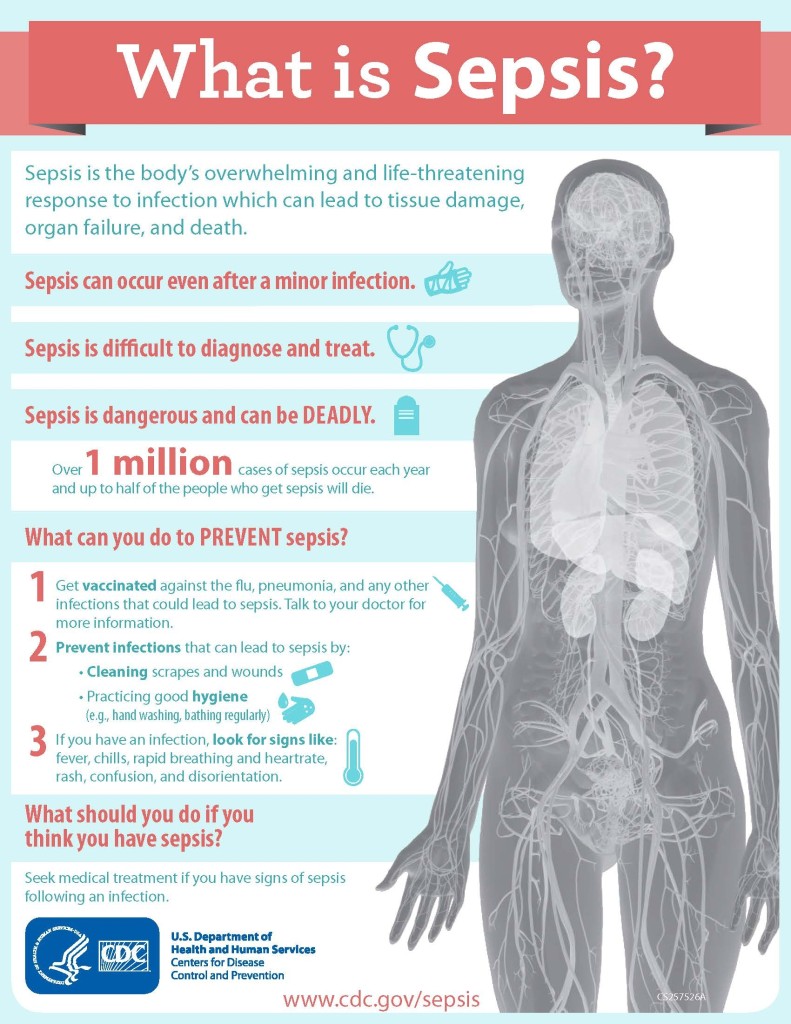Many years ago I had elective surgery. While I was happy with the outcome, I had an unwelcome side effect: a pretty awful infection at the incision site that took weeks to clear up. I’m not alone. Many people have contracted nasty infections from surgical procedures. Serious infections can also result from everyday cuts and scrapes. When I was a very young girl I contracted blood poisoning after stepping on a pine needle walking barefoot in the yard and had to be hospitalized. My symptoms were a red line creeping up my leg from my foot and pain.
Hearing the news this past week that the actress, Patty Duke, died from sepsis caused from a ruptured intestine has brought attention to a potentially deadly condition that I’ve learned is on the rise. According to the Centers for Disease Control and Prevention (CDC) the number of people hospitalized for septicemia (sepsis) has increased from 621,000 in 2000 to 1,141,000 in 2008. Between 28 and 50 percent of people who get sepsis die.

Patty Duke (source: IMDB)
There are many factors for this increase notes the CDC:
- the population is aging
- people have more chronic diseases
- peoples are getting more invasive procedures, immunosuppressive drugs, chemotherapy, and organ transplants
- increased antibiotic resistance
- increased awareness and tracking of sepsis in the medical community
But what is sepsis? According to the nonprofit Sepsis Alliance
Sepsis is the body’s overwhelming and life-threatening response to infection which can lead to tissue damage, organ failure, and death. Sepsis kills 258,000 Americans each year.
Medical professionals have been debating the exact definition of sepsis for decades. However, one thing they can agree upon is the origin of the disease. The word sepsis comes from the Greek meaning “decay” or “to putrefy.” In medical terms, sepsis is defined as either “the presence of pathogenic organisms or their toxins in the blood and tissues” or “the poisoned condition resulting from the presence of pathogens or their toxins as in septicemia.”
I was really surprised at how common sepsis is and how scarily easy it is to contract. Sepsis can occur after a minor infection, even from a scrape or cut! Hospitals, where we go to get well, can be incubators for infections if you are autoimmune compromised. And think twice before getting that elective surgical procedure! According to a report by the National Institute for Health (NIH), “Sepsis remains one of the leading causes of death in the United States and surgical patients account for approximately one third of all sepsis cases.” (*)
Understandably, many surgical procedures are necessary, life-saving procedures. But we’ve also read about people who’ve gone in for “routine” or elective surgery and faced lethal complications. Let’s face it: All surgery is risky. And while you may put yourself in the hands of the finest surgeons for whatever procedure you may be having, infections are creepy little ninjas that can take over your body with little warning.
Sepsis can be difficult to diagnosis. Many times symptoms are ignored may be confused with other conditions. Check out these CDC infographics:
This article in the Huffington Post does a great job explaining how difficult identifying and treating sepsis can be. Meanwhile, the CDC has several helpful infographics about sepsis including this one:
More info: Sepsis.org
I was pretty unclear what sepsis was when I started my research and curious to learn how it is different from a staph infection and blood poisoning. Because I like to dig in deep and learn how to help everyone be better informed, I’ve asked Dr. Minesh Khatri, Internist and Assistant Professor of Medicine at Columbia University Medical Center, to join me on Fearless Fabulous You Monday, April 4th, 4pmEST to explain what causes sepsis, symptoms, treatment and prevention.
Please listen and share all my shows. My mission is to inform and inspire women to live healthy, happy, purposeful lives. Live Mondays 4pmEST W4WN.com– the Women 4 Women Network. Listen to my podcasts anytime for free on iHeart.com and the iHeart App. Link

Inspiring women around the world, Read more at www.melanieyoung.com and please follow on Twitter@mightymelanie and Facebook/Fearless Fabulous Melanie Instagram.com/MelanieFabulous












